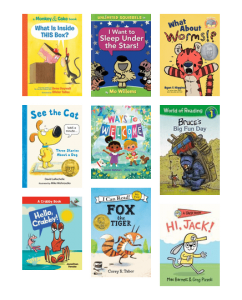 Are you questioning if Beginning Readers signifies kids learning to read or the books for Kindergarten through third grade? For this post, the answer is both!
Are you questioning if Beginning Readers signifies kids learning to read or the books for Kindergarten through third grade? For this post, the answer is both!
Parents of beginning readers often want to know the typical age when kids learn to read. There is no "correct age"; children start to read at their own pace. In fact, research indicates that learning to read later may be more beneficial when children's brains are ready to develop decoding and visual scanning skills. Most Scandinavian schools, for example, don't begin reading instruction until age 7.
Does the age at which a child begins to read correlate with reading ability, enjoyment, or even intelligence? No. Einstein allegedly did not start to read until the age of 9. And there are plenty of stories where the child who was the last to begin reading became the most proficient and enthusiastic reader.
Adults can support the emergent reading experience for children by warding off pressure to become independent readers.
Tips to encourage growing readers
Read, Read, Read
- Create a home environment where you emphasize words, reading, and listening to stories. Surround children with books in various formats and continue to read aloud daily, even after a child goes solo.
- Track words on the page while reading. Point to each word from left to right with your finger (or your child can point as you read).
- Involve children during reading aloud by asking questions, opens a new window to boost vocabulary, recall, and understanding of the story plot. Read the entire book to your child, then read it a second time and prompt with open-ended questions such as "What animal is this?", or "Which animal did we see at the zoo on Sunday?" to relate the story to personal experience.
Language
- Be intentional when introducing new words. When reading aloud a new book, focus on 1 or 2 unfamiliar words and give short, straightforward definitions.
- Attach meaning to unknown words. Look for smaller words within big words, use pictures as clues, figure out beginning and ending sounds, or skip the word and continue reading.
- Practice sight words (recognizable at a glance, like words "the" and "me") with playful reading games such as scavenger hunts around the house, or write words with play dough, Wikki Stix, and other fun materials. Avoid drills and flashcards; rote instruction can take the enjoyment out of reading.
- Introduce vocabulary and play with language. Play word, opens a new window games, rhyming games, or sing made-up rhymes. Throw in some complex words when talking about their interests.
- Use familiar words in new ways for children to discover different meanings for the same word. (e.g., the dog is running, my nose is running)
- Observe reading comprehension. Ask a child to:
-- Explain the plot or predict what might happen next in the story. "What do you think bunny will do next?"
-- Retell the story, act out with stuffed animals, or draw pictures.
-- Make connections from what they read to their own life. "Have you had the same feeling?"
Confidence
- Focus on self-esteem. Emphasize strengths (be specific and honest) by offering something the child is doing better than a couple of weeks ago. Reread familiar and favorite books to build confidence. As reading skills improve, increase the book-length rather than words per page to elevate self-esteem.
- Support a reader-in-training through patience, perseverance, and encouragement.
The most challenging stages of early reading development can be when transitioning to the next level. Here are some guidelines, accompanied by book recommendations, to demystify the entry levels of beginning reader books:
Pre-Readers
Provide a foundation for reading readiness. These short books boost sight word recognition and the ability to anticipate story events. The text has a few single syllable, easy-to-recognize words per page. An emphasis on illustrations with familiar characters supplies visual hints for word meaning.

Booklist Pre-Readers, opens a new window
Easy Readers
These stories assist emergent readers in reading independently. The text contains familiar words that are easy to sound out. Typically, Level 1 Easy Readers have 1-2 short sentences per page, often with rhyming and repetition. Illustrations on each page deliver clues to the text, add interest, and set the story's mood. The book-length is short, generally around 32 pages.
Level 2 and 3 Easy Readers often overlap with entry-level Easy Chapter books but have fewer pages.

Booklist Easy Readers, opens a new window
Easy Chapters
Offer the first introduction to chapters for independent readers or family storytime. The vocabulary is straightforward without complex descriptors. Easy Chapters use shorter sentences and paragraphs, have fewer pages per chapter, and include more illustrations than regular chapter books. The number of characters is smaller, and the plot is easier to follow, while engaging content maintains reader interest. Entry-level Easy Chapters have a larger font size with more space between lines and wide margins, and the page count is usually around 60 pages.


Booklist Easy Chapters, opens a new window Booklist Own Voices Easy Chapters, opens a new window
Browse more beginning reader booklists
Transitional Chapter, opens a new window
Favorites for Gr K -2, opens a new window
Sources
Galinsky, Ellen. (2010). Skill Three: Communicating. In Mind In The Making: The Seven Essential Life Skills Every Child Needs, opens a new window (pp. 132-156). 1st ed. New York: HarperCollins.
Shaffer, Sylvie. (2019, March 12). New for new readers: what (exactly) IS an Easy Reader?, opens a new window Horn Book [online magazine]
Taylor, Melissa. (2017, August 25). 8 ways to help kids understand what they read, opens a new window. Read Brightly [website article]
Whitehurst, Grover J. (Russ). (2018, July 3). Dialogic reading: an effective way to read aloud with young children, opens a new window. Reading Rockets [website]



Add a comment to: Beginning Readers K-Gr 3